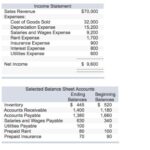
A few years back, I had checks belonging to someone else clearing in my account for three months in a row. If I hadn’t looked at the checks that were clearing to match them with my transactions, chances are I never would have spotted them. If you’ve never reconciled your accounts, or if you don’t reconcile them regularly, you should reconcile all of your accounts by the end of the year to prepare for tax season. Since all of your transaction info comes directly from your bank, reconciling should be a breeze. Now, simply compare the transactions on your statement with what’s in QuickBooks.
Edit completed reconciliations
Enter any bank service fees into the “Service charge” field and then select the date and the account used to track bank service fees from the adjacent “Date” and “Expense account” drop-downs. To enter interest earned, type the amount of interest earned into the “Interest earned” field. Then select the date and the income account used to track interest income, from the adjacent “Date” and “Income account” drop-downs. To reconcile the account after entering the statement information, click the “Start reconciling” button at the bottom of the window.
Once you’ve reviewed and matched all transactions, QuickBooks will calculate the difference between your records and your bank or credit card statement. If the difference is not zero, you may need to review your transactions again to find any discrepancies. This is an important procedure to ensure that the financial records reflect the actual annuity due state of the business’s transactions. It involves analyzing and adjusting any discrepancies in the previously reconciled transactions, thereby maintaining the integrity of the accounting system.
How to Reconcile Your Bank Statements in QuickBooks Online

This is done by noting discrepancies between transaction account the two accounts, finding the missing information, and making any additions or corrections in your general ledger. You’ll want to look at your statement, starting with the first transaction listed and find that same transaction in the Reconciliation window in QuickBooks. This process streamlines the reconciliation process, allowing for a seamless comparison between the company’s internal records and the bank’s official statement, thereby promoting financial accuracy and transparency. To return to finish the account reconciliation later, click the “Settings” button and then click the “Reconcile” link under the “Tools” heading in the drop-down menu again.
Access the Reconcile Tool
Be sure to note any transactions that appear in QuickBooks but are not on your statement, as well as any transactions on your bank statement that do not appear in QuickBooks. These reconciliation discrepancies should make up the difference between the two. To get started reconciling your accounts, just follow this easy three-step process.
- To get started reconciling your accounts, just follow this easy three-step process.
- After verifying the transactions and ensuring their alignment with the bank statement, QuickBooks Online allows users to mark the reconciliation as complete.
- This process plays a crucial role in maintaining the integrity of financial data and safeguarding against discrepancies.
- Adjustments may be necessary to rectify any inconsistencies and ensure that the financial records accurately reflect the actual bank activity.
- By cross-referencing the recorded transactions with the bank statement, discrepancies such as missing or duplicate entries can be identified and rectified, ensuring the accuracy of the financial records.
Your bank statement and your general ledger rarely match
This process involves comparing the transactions entered into QuickBooks Online with the bank statement to pinpoint any inconsistencies. By meticulously reviewing each transaction, users can detect potential errors such as duplicates, missing entries, or incorrect categorizations. This scrutiny plays a vital role in maintaining accurate financial records, helping businesses to reconcile their accounts with precision. It plays a crucial role in ensuring the financial accuracy and integrity of a company’s records.
Once this is completed, any difference between the two balances will be highlighted on the reconciliation page. If you have very limited transactions for the month, your QuickBooks Online and bank statement balances may match, which is rare but would indicate that further reconciliation is not needed. While connecting your bank account directly to an accounting software application such as QuickBooks Online makes it easier to track and match transactions, you still need to complete the reconciliation process. For example, if your bank regularly charges you a service fee each month, it will not be posted into your general ledger, leaving you with an inaccurate balance. Assuming there are no other outstanding transactions that need to be posted, once you record the bank service fee in your general ledger, your bank balance and general ledger balance should gross pay vs net pay: whats the difference match. Bank account reconciliation is used to ensure that your general ledger balance and your bank balance match.
You may need to take into consideration when reconciling your accounts whether you’ve connected your bank accounts to the application or you’re just uploading your transactions electronically at month-end. Here are a few other things you may want to consider when using QuickBooks Online. If you adjusted a reconciliation by mistake or need to start over, reach out to your accountant. Reviewing transactions in QuickBooks Desktop is essential to identify any discrepancies and ensure that the recorded transactions correspond accurately with the bank statement. Reviewing transactions in QuickBooks Online is essential to identify any discrepancies and ensure that the recorded transactions correspond accurately with the bank statement. From accessing the reconcile tool to marking transactions as cleared, we’ve got you covered.
Reconciling a bank account in QuickBooks Desktop involves a series of structured procedures to ensure the accurate alignment of the financial records with the bank statement, reflecting the precise financial position. Reconciling previous months in QuickBooks Online involves the process of retroactively matching the financial records with the bank statements for specific past periods to ensure comprehensive financial accuracy. Then, input the closing balance from the bank statement and ensure that all transactions are accurately reflected. This process is essential for maintaining accurate financial information and ensuring that the company’s records are in line with its actual financial position. After entering the statement date and ending balance, you’ll see a list of transactions that need to be reviewed and matched.
